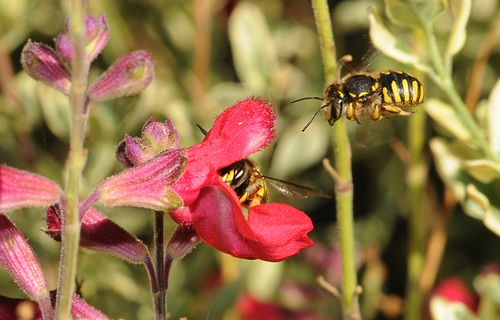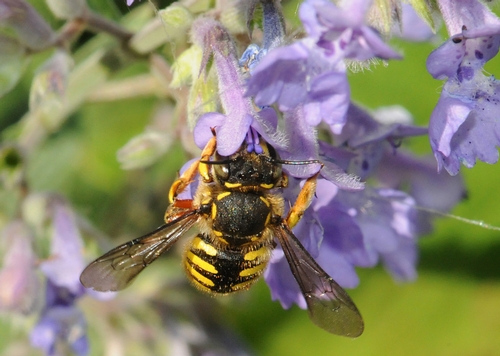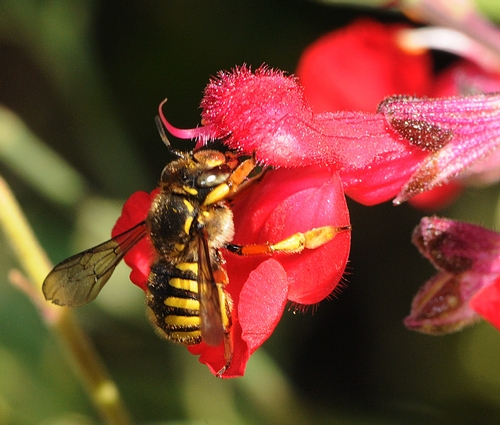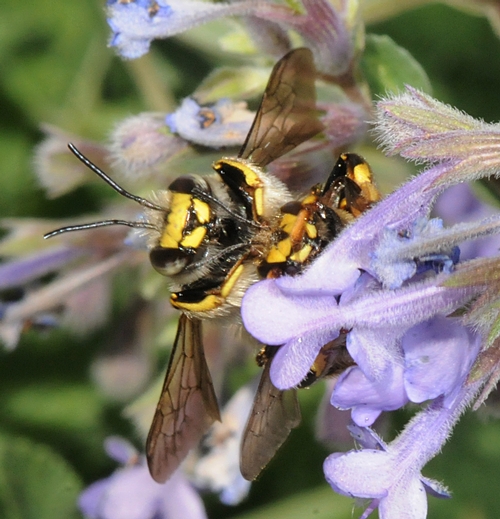Last summer we watched European wool carder bees (Anthidium manicatum) dart in and out of the catmint and salvia in our bee friendly garden.
The males are very territorial, so they'd chase away honey bees, bumble bees, hover flies and other insects from THEIR flowers. Yes, they claimed them. Here I thought the flowers belonged to our family--silly me. The male wool carder bees took possession.
From dawn to dusk, the males would patrol the flower bed. They'd allow the female wool carder bees to drop by for nectar and to card the fuzz from the leaves to build their nests.
And they'd mate with them--not in mid-air as honey bees do, but on the plants.
Occasionally a male wool carder bee would bodyslam a honey bee. But she'd right herself, select another blossom, and gather more nectar--this time a little faster.
That's the way of things in the ecological world.
However, this week the wool carder bees turned into terrorists. A Sacramento area resident, interviewed on a local TV station, claimed that the wool carder bees target honey bees and are turning his flower bed and the neighborhood into blood-soaked battlefields. The male “cuts off their wings, cuts off their antenna, cuts off their heads, cuts off their torsi (tarsi) and stabs them to death.”
And all of a sudden, the story goes viral and our UC Davis entomologists are fielding a flurry of calls.
“The species (Anthidium manicatum) was first collected in Sunnyvale, Calif. in 2007 and it was well established in the Central Valley by 2008,” said entomologist Lynn Kimsey, director of the Bohart Museum of Entomology (home of more than seven million insect specimens, including wool carder bees) and professor and former chair of the UC Davis Department Entomology.
“Males are territorial and very aggressive, attacking any insect that enters its territory that isn't a wool-carder female,” Kimsey said. “The males establish territories around flowering plants, so they will attack honey bees and any other bees coming to visit the flowers."
“The number of honey bees that wool carder bees kills is probably no different than those honey bees lost to praying mantids, phorid flies and spiders,” said honey bee expert Eric Mussen, Extension apiculturist with the UC Davis Department of Entomology faculty.
Bohart Museum research entomologists Tom Zavortink and Sandy Shields (she's now at Port Townsend, Wash.) shed new light on the wool carder bee when they published their work in a 2008 edition of the Pan-Pacific Entomologist.
Native pollinator specialist Robbin Thorp, emeritus professor of entomology at UC Davis, also studies the wool carder bees.
“Males have been observed and recorded to occasionally maim and kill honey bees, but they are no major threat to our primary agricultural pollinator,” Thorp said. “They do not aggressively seek out honey bees to do them intentional harm. The male wool carder bee merely defends its territory from honey bees and other flying insects to keep the area free of potential competitors that might interfere with its mating opportunities. This non-native bee has co-existed with honey bees in Europe for hundreds of thousands of years.”
“A. manicatum appeared this past summer in our Haagen-Dazs Honey Bee Haven (the half-acre bee friendly garden planted next to the Harry H. Laidlaw Jr. Honey Bee Research Facility at UC Davis) but I have yet to see it maim or kill a honey bee,” Thorp said. “I am certainly not planning to recommend that we move our UC Davis Apiary from the area or take extraordinary means to protect our precious honey bees because of the presence of this relative newcomer. Nor would I recommend we attempt to control or get rid of the ‘newbie.’ It is another pollinator, males visit flowers for nectar and females visit for pollen and nectar.”
Meanwhile, some folks are calling the wool carder bees "killer bees" and blaming them general mayhem and even colony collapse disorder.
The story went viral and it might take some doing to correct the misinformation.
“The story is being gobbled up by the general public due to all the media hype,” Thorp said. “I just had a UPS delivery guy ask me about “this new bee that is destroying our honey bees.”
Attached Images:

Wool Carder Bees

Sip of Nectar

Salvia

Mating Pair